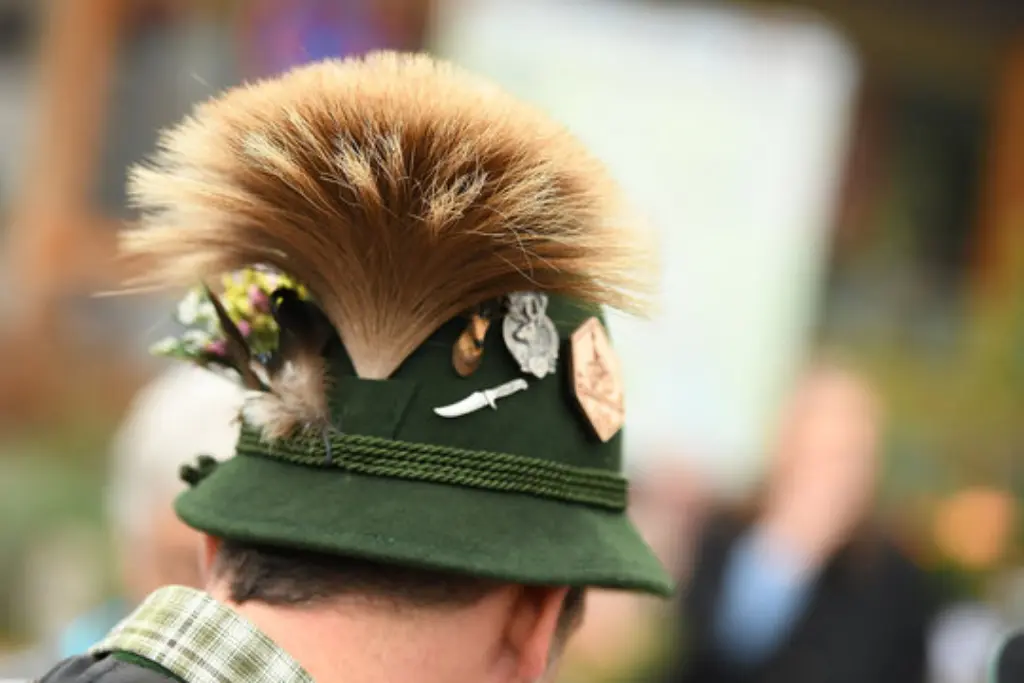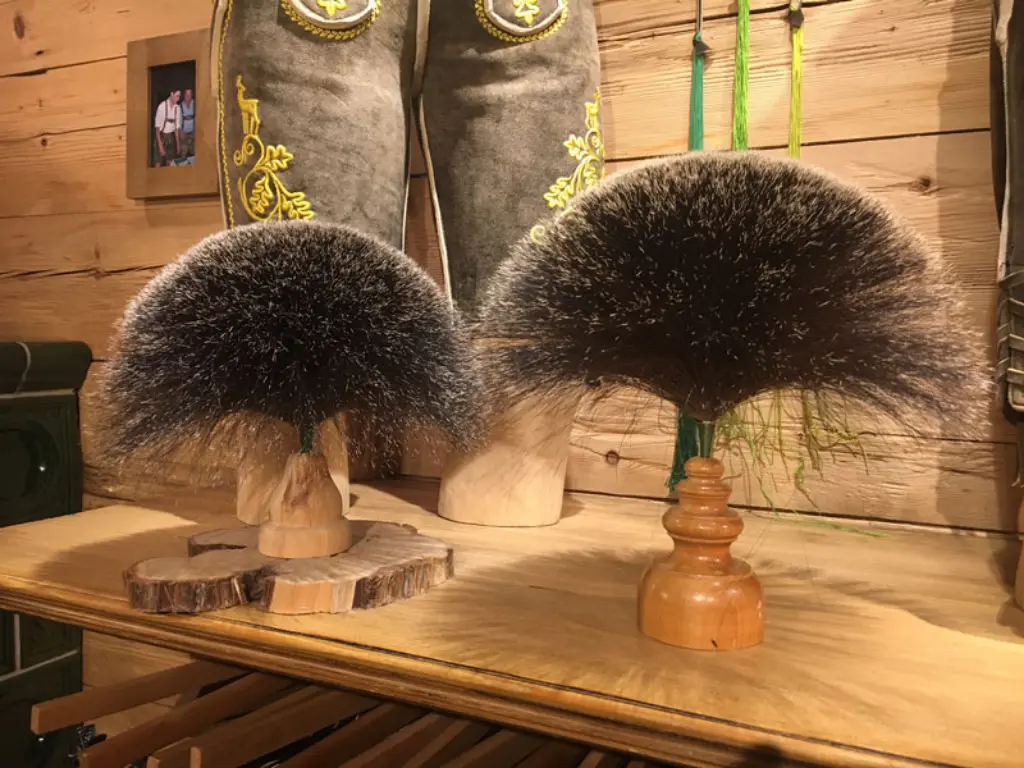The Gamsbart, a seemingly simple tuft of hair, is far more than just a decorative piece. It’s a powerful symbol deeply rooted in the culture of the Alpine regions of Europe, particularly Bavaria, Austria, and parts of Switzerland and Italy.
This traditional ornament, often seen adorning hats, carries with it a rich history, embodying hunting traditions, regional identity, and even social status. Let’s delve into the fascinating world of the Gamsbart and uncover its story.
What Exactly is a Gamsbart?
At its most basic, a Gamsbart is a brush-like ornament made from the hair of the chamois (Gams in German), a goat-antelope native to the Alps. These hairs, typically taken from the back of the animal, are carefully arranged and attached to a handle, often made of bone, horn, wood, or more recently, plastic. The finished product is a distinctive, feathery tuft that can range in size from just a few centimeters to impressive, elaborate displays.

The Historical Significance of the Gamsbart
The Gamsbart’s origins are closely tied to the hunting culture of the Alpine region. Historically, chamois hunting was a challenging and dangerous pursuit, and a successful hunt was a source of pride and prestige. The hunter’s trophy was not only the animal itself, but also parts like the hide and, most notably, the hair used to create the Gamsbart. It served as a symbol of their skill, bravery, and connection to the mountains.
See alsoBeyond Hunting: Social Status and Tradition
Over time, the Gamsbart evolved beyond its practical hunting origins into a symbol of social status and regional identity. The size, fullness, and quality of the Gamsbart became indicators of a hunter’s prowess and, by extension, their social standing within the community.
A larger, denser, and well-maintained Gamsbart signified a more experienced and respected hunter. This tradition continues today, where Gamsbart ownership is often viewed as a matter of pride and connection to heritage.
Furthermore, the Gamsbart became an integral part of traditional Alpine attire, often worn with Trachten, the traditional clothing of the region. These outfits, worn during celebrations, festivals, and other cultural events, are incomplete without the characteristic Gamsbart on the hat.
The Art of Making a Gamsbart
The creation of a Gamsbart is a craft that has been passed down through generations. While some modern versions utilize more automated techniques, traditional Gamsbart making remains a laborious and meticulous process.
See also Keffiyeh: A Symbol of Heritage, Resistance, and Global Fashion
Keffiyeh: A Symbol of Heritage, Resistance, and Global Fashion
Harvesting the Hair
The process begins with the careful harvesting of the hair from the chamois. The hair, typically taken from the back of the animal, is selected for its length and quality. Experienced craftspeople can tell at a glance which hairs will be suitable for a fine Gamsbart.
Preparing the Hair
Once collected, the hair needs to be cleaned and processed. This involves removing any dirt, grease, and other impurities. The hair is then often carefully sorted by length and quality to ensure consistency in the final product.
Assembling the Gamsbart
The individual hairs are then assembled into a brush-like form. This is a delicate process where skilled artisans meticulously arrange the hairs, often using tools like combs and tweezers. The hair is then bound together at the base, and this bound end is then attached to the handle. The type of handle can vary depending on the tradition or region and materials like bone, horn, wood, and plastic can be used. The attachment process can involve glues, stitching, and other fastening methods.
Finishing Touches
Once the Gamsbart is assembled, it may receive further finishing touches. These can include trimming, shaping, and sometimes the addition of decorative elements, such as a small metal cap or a decorative pin. These finishing touches often give each Gamsbart a unique and personal character.
Variations in Style and Regional Differences
While the core elements of a Gamsbart remain consistent, there are notable variations in style and design across the different Alpine regions. These variations often reflect local traditions and preferences.
Size and Shape
The size of a Gamsbart can range from small and compact to large and dramatic. The shape also varies, with some being more rounded while others are more elongated and feathery. Regional styles are often dictated by historical preference and can be indicators of an individual’s background.
Handle Materials
The materials used for the handle also contribute to regional differences. Traditionally, horn and bone were common choices, reflecting the readily available resources from hunting. Today, wood and even plastic handles are also commonly found, especially in more commercially produced Gamsbart.
Decorative Elements
Decorative elements like metal caps, pins, and even small feather accents can vary widely, offering additional regional distinction and personal expression.
The Gamsbart Today
The Gamsbart is not just a relic of the past; it remains a vibrant part of Alpine culture. While the traditional hunting aspect has diminished, the Gamsbart’s symbolic value persists. It is still worn during festivals, cultural events, and special occasions. While some wearers are hunters, others wear the Gamsbart simply as a symbol of their heritage and connection to the mountains.
The Gamsbart in Modern Fashion
Beyond its traditional use, the Gamsbart has also found its way into modern fashion, sometimes being incorporated into hats, jackets, and other clothing items. While these modern interpretations may not hold the same symbolic weight as traditional Gamsbart, they help to keep the cultural heritage alive and accessible.
Challenges and Sustainability
The demand for Gamsbart hair does pose challenges regarding sustainability and ethical considerations. Responsible practices focus on utilizing the hair from animals harvested as part of a managed hunting process. Conservation and proper game management help ensure that chamois populations remain healthy and that the tradition can continue responsibly.
Caring for a Gamsbart
A Gamsbart, particularly a high-quality one, is a valuable item and requires proper care to maintain its appearance and longevity.

Cleaning and Maintenance
Regularly brushing the Gamsbart with a soft brush can help remove dust and dirt. Avoid using harsh chemicals or soaps, which can damage the hair. When cleaning is necessary, consider using a very gentle detergent or simply lukewarm water. Always allow the Gamsbart to dry naturally, avoiding direct sunlight or heat.
Storage
When not in use, store your Gamsbart in a dry place, away from moisture. A dedicated box or container can help protect it from dust, insects, and damage.
Handling
Handle your Gamsbart with care, avoiding unnecessary pulling or bending. Gentle treatment will ensure that the hair remains intact and does not become damaged.
The Gamsbart is more than just a decorative item; it is a tangible piece of Alpine history and culture. From its origins as a hunter’s trophy to its modern-day role as a symbol of heritage, the Gamsbart embodies tradition, skill, and connection to the mountains.
This unique ornament is a living testament to the rich cultural tapestry of the Alpine regions. Its enduring presence serves as a reminder of the importance of preserving traditions while responsibly navigating the present. By understanding the history and significance of the Gamsbart, we gain a deeper appreciation for the cultural landscape it represents.
The Gamsbart continues to be a powerful and evocative symbol, weaving together the past, present, and future of the Alpine people. If you encounter this fascinating ornament, you now possess the knowledge to understand its deeper meaning.



